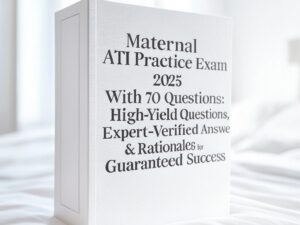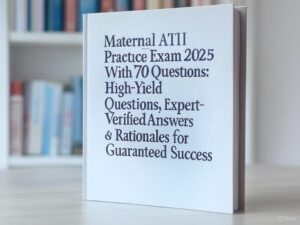Boost your preparation for the Maternal ATI Exam 2025 with this expertly crafted practice guide, featuring 70 high-yield questions, expert-verified answers, and detailed rationales to ensure your success. Tailored for nursing students and professionals, this resource dives deep into essential maternal and newborn care topics, aligning with the latest 2025 ATI exam standards. Whether you’re studying for the NCLEX, ATI testing, or maternal nursing certification, this guide provides the tools you need to excel in your nursing career.
Key features include:
-
70 carefully selected high-yield questions covering critical maternal health topics
-
Expert-verified answers with in-depth rationales for better understanding
-
Content updated to reflect the 2025 Maternal ATI exam format and standards
-
Ideal for NCLEX preparation, ATI testing, and maternal nursing certification
-
Proven strategies to enhance retention and improve exam performance
Study smarter, master maternal health concepts, and pass your exam with confidence using this essential Maternal ATI practice resource.
Preview
1. A nurse is caring for a client who is in labor. The nurse decides to switch from
intermittent auscultation to continuous fetal monitoring. Which of the following data
can only be obtained from continuous electronic fetal monitoring?
A. Determination of a baseline
B. Determination of variability
C. Presence of accelerations
D. Presence of decelerations
Correct Answer: B – Determination of variability
Rationale: Continuous electronic fetal monitoring is required to determine variability, as it
provides a visual tracing that allows the nurse to assess fluctuations in the fetal heart rate.
2. While assessing a client in the fourth stage of labor, the nurse suspects bladder
distention. Which of the following findings should the nurse anticipate with bladder
distention?
A. The fundus is at midline.
B. The fundus is below the umbilicus.
C. The bladder is resonant with percussion.
D. The bladder fluctuates with palpation.
Correct Answer: D – The bladder fluctuates with palpation
Rationale: A distended bladder will feel soft and fluctuate with palpation, as it is filled with
f
luid. This can interfere with uterine contractions and lead to postpartum hemorrhage.
3. A nurse is reviewing the plan of care before assuming care of a newborn prescribed
a hepatitis B vaccine, vitamin K, and an antiretroviral regimen. The plan indicates that
the newborn’s mother is HIV-positive and plans to breastfeed. Which finding should
the nurse address with the newborn’s interdisciplinary team?
A. Hepatitis B vaccine
B. Antiretroviral regimen
C. Vitamin K
D. Breastfeeding
Correct Answer: D – Breastfeeding
Rationale: HIV can be transmitted through breast milk. In areas with access to formula and
clean water, breastfeeding by an HIV-positive mother is contraindicated and should be
addressed with the healthcare team.
4. A nurse is assessing a client who is at 26 weeks of gestation and has mild
preeclampsia. Which of the following findings should the nurse report to the provider?
A. Platelet count 97,000/mm³
B. Deep tendon reflexes 4+
C. Urine protein 1+
D. BUN 22 mg/dL
Correct Answer: B – Deep tendon reflexes 4+
Rationale: Hyperactive deep tendon reflexes (DTRs) are an indication of worsening
preeclampsia, increasing the risk for seizures. The nurse should notify the provider
immediately.
intermittent auscultation to continuous fetal monitoring. Which of the following data
can only be obtained from continuous electronic fetal monitoring?
A. Determination of a baseline
B. Determination of variability
C. Presence of accelerations
D. Presence of decelerations
Correct Answer: B – Determination of variability
Rationale: Continuous electronic fetal monitoring is required to determine variability, as it
provides a visual tracing that allows the nurse to assess fluctuations in the fetal heart rate.
2. While assessing a client in the fourth stage of labor, the nurse suspects bladder
distention. Which of the following findings should the nurse anticipate with bladder
distention?
A. The fundus is at midline.
B. The fundus is below the umbilicus.
C. The bladder is resonant with percussion.
D. The bladder fluctuates with palpation.
Correct Answer: D – The bladder fluctuates with palpation
Rationale: A distended bladder will feel soft and fluctuate with palpation, as it is filled with
f
luid. This can interfere with uterine contractions and lead to postpartum hemorrhage.
3. A nurse is reviewing the plan of care before assuming care of a newborn prescribed
a hepatitis B vaccine, vitamin K, and an antiretroviral regimen. The plan indicates that
the newborn’s mother is HIV-positive and plans to breastfeed. Which finding should
the nurse address with the newborn’s interdisciplinary team?
A. Hepatitis B vaccine
B. Antiretroviral regimen
C. Vitamin K
D. Breastfeeding
Correct Answer: D – Breastfeeding
Rationale: HIV can be transmitted through breast milk. In areas with access to formula and
clean water, breastfeeding by an HIV-positive mother is contraindicated and should be
addressed with the healthcare team.
4. A nurse is assessing a client who is at 26 weeks of gestation and has mild
preeclampsia. Which of the following findings should the nurse report to the provider?
A. Platelet count 97,000/mm³
B. Deep tendon reflexes 4+
C. Urine protein 1+
D. BUN 22 mg/dL
Correct Answer: B – Deep tendon reflexes 4+
Rationale: Hyperactive deep tendon reflexes (DTRs) are an indication of worsening
preeclampsia, increasing the risk for seizures. The nurse should notify the provider
immediately.












Reviews
There are no reviews yet.